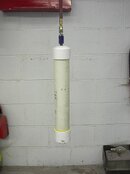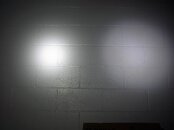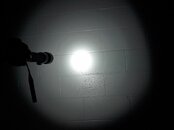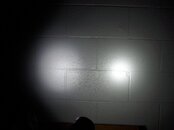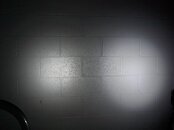I made a test chamber out of 3" PVC, a female adapter with plug on one end, and a cap on the other that was drilled and tapped for ¼" NPT, where I screwed in an air nipple. I did an initial test before installing the reed switch assembly and LED module, and instead filled the light with weights so it would sink. Lube all the o-rings with silicone grease. Put it in the test chamber and fill with water. It took a lot of Teflon tape to seal the threads on the 3" female adapter/plug. Connect an air hose to the nipple and pressurize. I went to 155 psi, which should be about 350ffw. After final assembly of the complete light, I tested again @ 155 psi for two hours. No leaks!
You are using an out of date browser. It may not display this or other websites correctly.
You should upgrade or use an alternative browser.
You should upgrade or use an alternative browser.
Diy Light, 800 Lumen, 4 Power Levels
- Thread starter bradsab
- Start date
Please register or login
Welcome to ScubaBoard, the world's largest scuba diving community. Registration is not required to read the forums, but we encourage you to join. Joining has its benefits and enables you to participate in the discussions.
Benefits of registering include
- Ability to post and comment on topics and discussions.
- A Free photo gallery to share your dive photos with the world.
- You can make this box go away
The only light I have to compare this with is a Princeton Tech Miniwave LED, rated at 150 lumens. As you can see from the beam shots, the MT-4 has an intense hot spot and a lot of spill. (Fresh batteries in both lights for the comparison shots.) Lord willing, were going to Bonaire in March, and Ill post again when we return. Total cost was about $160 plus shipping.
This makes a great tactical light for above water, but the optics are not ideal for diving; theres too much spill. I dont know how it will be underwater, but most likely, the lumens in the spill area will be wasted. If all the energy were contained in a little broader hot spot, this would be a scorcher! Above water, its a good balance: I can hold this light out the window and drive with my headlights off .
.
I'll try to describe the beam shots attached to this post. Photo 1 is the MT-4 Maglite on the left, Princeton Tech Miniwave LED on the right, both on high power, 6' from a white painted block wall. The MT-4 is slightly yellow to the Miniwave, which almost looks a little violet in comparison. Photo 2 is the MT-4 on high, 3' from the wall.
What none of the pictures show is the amount of spill, it is brighter than the pic shows. The hot spot is so bright the rest of the pic is underexposed. When driving at night with only the Maglite on and headlamps off, the road is well lit and signs 1/4 mile+ ahead are illuminated, and there is enough spill to see the ditches on a county highway. This, I think, is wasted lumens for a dive light. It would be interesting to play with different reflectors to see if this could be focused better. These reflectors are 17mm, and there would be room for slightly larger ones.
The Miniwave has a very nice beam pattern for a dive light. It does not have reflectors, rather, each emitter has a culminating lens that generates a very even beam with fairly low divergence. The lens' are way to big to fit four of them in a Maglite head, but it would be interesting to see what they could do with the Seoul P4.
Photo 3 is both lights on high approx. 3' from the wall, Miniwave on left, MT-4 Maglite on right. Photo 4 is the Maglite on it's lowest power (1 emitter), and the Miniwave on high. Here is where the beam patterns really differ. By eye only, the lux of both hot spots look about the same. But there is almost no spill from the Miniwave, and it's spot is much larger. Shine both lights around a dark room, and the MT-4 lights up everything while the Miniwave still only has the spot, and the rest of the room remains dark.
The reflectors and Seoul P4 emitters are all epoxied to the heat sink, so I can't change things around. We'll just have to wait and see how this performs under water. It's been a fun project. Maybe some of you can improve upon it.
-Brad
This makes a great tactical light for above water, but the optics are not ideal for diving; theres too much spill. I dont know how it will be underwater, but most likely, the lumens in the spill area will be wasted. If all the energy were contained in a little broader hot spot, this would be a scorcher! Above water, its a good balance: I can hold this light out the window and drive with my headlights off
I'll try to describe the beam shots attached to this post. Photo 1 is the MT-4 Maglite on the left, Princeton Tech Miniwave LED on the right, both on high power, 6' from a white painted block wall. The MT-4 is slightly yellow to the Miniwave, which almost looks a little violet in comparison. Photo 2 is the MT-4 on high, 3' from the wall.
What none of the pictures show is the amount of spill, it is brighter than the pic shows. The hot spot is so bright the rest of the pic is underexposed. When driving at night with only the Maglite on and headlamps off, the road is well lit and signs 1/4 mile+ ahead are illuminated, and there is enough spill to see the ditches on a county highway. This, I think, is wasted lumens for a dive light. It would be interesting to play with different reflectors to see if this could be focused better. These reflectors are 17mm, and there would be room for slightly larger ones.
The Miniwave has a very nice beam pattern for a dive light. It does not have reflectors, rather, each emitter has a culminating lens that generates a very even beam with fairly low divergence. The lens' are way to big to fit four of them in a Maglite head, but it would be interesting to see what they could do with the Seoul P4.
Photo 3 is both lights on high approx. 3' from the wall, Miniwave on left, MT-4 Maglite on right. Photo 4 is the Maglite on it's lowest power (1 emitter), and the Miniwave on high. Here is where the beam patterns really differ. By eye only, the lux of both hot spots look about the same. But there is almost no spill from the Miniwave, and it's spot is much larger. Shine both lights around a dark room, and the MT-4 lights up everything while the Miniwave still only has the spot, and the rest of the room remains dark.
The reflectors and Seoul P4 emitters are all epoxied to the heat sink, so I can't change things around. We'll just have to wait and see how this performs under water. It's been a fun project. Maybe some of you can improve upon it.
-Brad
Attachments
Great piece of work, thank you.
elektrolumens
Registered
- Messages
- 5
- Reaction score
- 0
Nice work Brad!
This is wayne, from Elektro Lumens. Thanks for emailing me with a link to your post about this light. I just registered, so this is my first here in this forum. I can appreciate how much work you put into the building of this dive light.
Wayne
This is wayne, from Elektro Lumens. Thanks for emailing me with a link to your post about this light. I just registered, so this is my first here in this forum. I can appreciate how much work you put into the building of this dive light.
Wayne
nwbrewer
Contributor
Very nice work! I'e been thinking of upgrading my canlight for a while now, this might be kind of a nice drop in. I use a really similar reed switch type setup, but my magnet is in my goodman handle. I couldn't follow all of what you had to do to the cup to get it to fit though, I may be contacting Wayne to see what he can do.
My only other question is are you direct driving the LED's then? Is there a way to incorporate a driver if there isn't one? I thought drivers made it more efficient?
Jake
My only other question is are you direct driving the LED's then? Is there a way to incorporate a driver if there isn't one? I thought drivers made it more efficient?
Jake
Nice work Brad!
This is wayne, from Elektro Lumens. Thanks for emailing me with a link to your post about this light. I just registered, so this is my first here in this forum. I can appreciate how much work you put into the building of this dive light.
Wayne
Hello Wayne,
Welcome to SB, I look forward to your post. (and picking your brain
c
Very nice work! I'e been thinking of upgrading my canlight for a while now, this might be kind of a nice drop in. I use a really similar reed switch type setup, but my magnet is in my goodman handle. I couldn't follow all of what you had to do to the cup to get it to fit though, I may be contacting Wayne to see what he can do.
My only other question is are you direct driving the LED's then? Is there a way to incorporate a driver if there isn't one? I thought drivers made it more efficient?
Jake
Jake-
Now that Wayne is on the board, he'd be the one to ask. The LED's are direct driven. I'm not familiar with drivers, but there would be room between the switch and heat sink for something small. I wish I understood LED's & drivers more, I'd play around with stuff just for fun.
-Brad
elektrolumens
Registered
- Messages
- 5
- Reaction score
- 0
Jake-
Now that Wayne is on the board, he'd be the one to ask. The LED's are direct driven. I'm not familiar with drivers, but there would be room between the switch and heat sink for something small. I wish I understood LED's & drivers more, I'd play around with stuff just for fun.
-Brad
Very nice work! I'e been thinking of upgrading my canlight for a while now, this might be kind of a nice drop in. I use a really similar reed switch type setup, but my magnet is in my goodman handle. I couldn't follow all of what you had to do to the cup to get it to fit though, I may be contacting Wayne to see what he can do.
My only other question is are you direct driving the LED's then? Is there a way to incorporate a driver if there isn't one? I thought drivers made it more efficient?
Jake
The LED assembly I built for Brad is direct drive. According to his special request (an extreme variation of an LED drop-in for a D cell Maglite), each LED has 2 wires, 8 in all, which he connected to his own switch. This settup has to run from 3 batteries, and preferably using NIMH rechargables.
Many people think a driver makes the system more efficient, but I don't think so. A typical boost circuit is around 80% efficient. A typical scenario is boosting from 3.0V to the Vf of the LED, from 3.2V to 3.75V. But when powering 4 LEDs, this is not a good way to do it, and actually, is a terrible way to do it. To power 4 LEDs, you'd go with a buck regulator and perhaps 12V input. But the settup I've set Brad up with, powers 4 LEDs at 200 lumens each, and will do so for up to 3 hours, if 12,000mAh D cells are used. Anyway, that's just the way I typically do it.
The 4 LED settup is remarkably simple, yet it works as well as a very complicated and sophisticated voltage regulated system. I'd suppose for diving you'd prefer something that is first of all reliable?
Wayne
nwbrewer
Contributor
The LED assembly I built for Brad is direct drive. According to his special request (an extreme variation of an LED drop-in for a D cell Maglite), each LED has 2 wires, 8 in all, which he connected to his own switch. This settup has to run from 3 batteries, and preferably using NIMH rechargables.
Many people think a driver makes the system more efficient, but I don't think so. A typical boost circuit is around 80% efficient. A typical scenario is boosting from 3.0V to the Vf of the LED, from 3.2V to 3.75V. But when powering 4 LEDs, this is not a good way to do it, and actually, is a terrible way to do it. To power 4 LEDs, you'd go with a buck regulator and perhaps 12V input. But the settup I've set Brad up with, powers 4 LEDs at 200 lumens each, and will do so for up to 3 hours, if 12,000mAh D cells are used. Anyway, that's just the way I typically do it.
The 4 LED settup is remarkably simple, yet it works as well as a very complicated and sophisticated voltage regulated system. I'd suppose for diving you'd prefer something that is first of all reliable?
Wayne
I was looking at using a driver since I power mine through 2.7ah AA batteries. So on 3 D NiMh batteries direct driving all 4 gives 3 hours? That's not too bad actually. For the diving I do, I'd want all or nothing, so they would be just hooked up in series then?
Similar threads
- Replies
- 2
- Views
- 135
- Replies
- 1
- Views
- 558
- Replies
- 8
- Views
- 905
- Replies
- 6
- Views
- 1,163
- Replies
- 0
- Views
- 565




